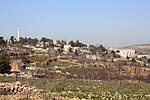Battle of 3 Shevat
1948 in Israel1948 in Mandatory PalestineBattles and operations of the 1948 Arab–Israeli WarJanuary 1948 events in Asia
The Battle of 3 Shevat was a battle in the 1947–1949 Palestine war, fought on January 14, 1948 (Hebrew date: 3 Shevat). The battle began with a large attack on Gush Etzion by Arab groups in the area, reinforced by Arabs and Bedouins who came from as far as Jerusalem and Beer Sheva, under the command of Abd al-Qadir al-Husayni. They attempted to capture the center of Gush Etzion, and to divide the four settlements of Gush Etzion into two separate enclaves. Their attack was repulsed, at the cost of heavy losses to the attackers.
Excerpt from the Wikipedia article Battle of 3 Shevat (License: CC BY-SA 3.0, Authors).Battle of 3 Shevat
HaAlon,
Geographical coordinates (GPS) Address Nearby Places Show on map
Geographical coordinates (GPS)
| Latitude | Longitude |
|---|---|
| N 31.65962 ° | E 35.12437 ° |
Address
האלון
HaAlon
Judea and Samaria, Palestinian Territories
Open on Google Maps









